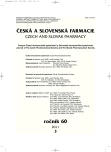Influence of membranes on alaptide permeation from hydrogels
Authors:
Zuzana Vitková; Veronika Šmunková; Petra Herdová; Marián Žabka
Authors‘ workplace:
Univerzita Komenského Bratislava, Farmaceutická fakulta, Katedra galenickej farmácie
Published in:
Čes. slov. Farm., 2011; 60, 132-136
Category:
Original Articles
Overview
The paper evaluates the liberation of alaptide from gels through various types of permeable membranes. The gels were prepared on the basis of three different polymers (3% chitosan; 2.5% hydroxypropyl cellulose; 3% hydroxyethyl cellulose) in different concentrations with additions of humectants (5 %; 15% propylene glycol and 10% glycerol) and the preserving agent, 0.3% Sepicide HBR with 1% alaptide, and finally without the drug. The permeation of the drug from gels into the acceptor solution was evaluated with the use of the following membranes: the hydrophilic membrane from Chemosvit, the chicken skin, the stripped snakeskin, and the wall of the small intestine. The measurements showed that the highest percentage of the drug penetrated through the small intestine, a smaller percentage through the chicken skin, and the smallest amount through the snakeskin. Rheological properties of the prepared hydrogels were evaluated as well. The pseudo-plastic flow was only confirmed for the hydrogel prepared on the basis of hydroxypropyl cellulose. An utterly opposite situation was with the hydrogels prepared on the basis of chitosan and hydroxyethyl cellulose. They showed a significant thixotropic character and the degree of thixotropy increased with time. Based on the results of the pH measurement, the samples prepared on the basis of chitosan and hydroxypropyl cellulose have been shown to be inconvenient because they reached a lower pH and had a potential of causing skin irritation. The hydroxyethyl cellulose hydrogel matched the physiological values of skin pH even after 14 days since its preparation.
Key words:
alaptide – hydrogel – permeable membrane – rheological properties
Sources
1. Attwood, D., Florence, A. T.: Physical Pharmacy. London: Pharmaceutical Press 2008; 86, 88, 98, 99, 109-110, 111-112, 115, 137, 146.
2. Park, J. H., Lee, J. W., Kim, Y. C., Prausnitz, M. R.: The effect of heat on skin permeability. Int. J. Pharm. 2008; 359 (1–2), 94–103.
3. Owen, D. H., Peters, J. J., Lavine, M. L., Katz, D. F.: Effect of temperature and pH on contraceptive gel viscosity. Contraception 2003; 67 (1), 57–64.
4. Bronaugh, R. L., Maibach, H. I.: Topical absorption of dermatological products. New York: Marcel Dekker, Inc Portions. 2001; 291, 317–318, 459, 516.
5. Gallagher, S. J., Trottet, L., Heard, C. M.: Ketoprofen: release from, permeation across and rheology of simple gel formulations that simulate increasing dryness. Int. J. Pharm. 2003; 268 (1–2), 37–45.
6. Galaev, I., Mattiasson, B.: Smart polymers, Applications in Biotechnology and Biomedicine. 2. vyd. Boca Raton: CRC Press, Taylor & Francis Group. 2008; 99, 101, 177–178, 204–205, 301, 367–370, 408, 428.
7. Nedvídková, J., Kasafírek, E., Nedvídek, J., Pacák, K., Schreiber, V.: An analog of MIF, alaptide: effect on serum prolactin, dopamine receptors and growth of rat adenohypophysis. Endocrine Res. 1994; 20(1), 39–46.
8. Jakubke, H. D., Sewald, N.: Peptides from A to Z Conscise Encyclopedia. Weinheim: WILEY-VCH Verlag GmbH & Co. KGaA. 2008; s. 217, 315.
9. Metodika řešení struktur organických látek z práškových dat. www.vscht.cz/.../Metodika_reseni_ struktrur_organickych_latek_uloha33a.doc [cit. 24-02-2011].
10. http://www.bioveta.sk/sortiment_dermatologika_alaptid. html [cit. 24-02-2011].
11. Senel, S., Mcclure, S. J.: Potential applications of chitosan in veterinary medicine. Advanc. drug deliv. Rev. 2004; 56(10), 1467–1480.
12. Boucard, N. a kol.: The use of physical hydrogels of chitosan for skin regeneration following third-degree burns. Biomaterials 2007; 28(24), 3478–3488.
13. Vitková, Z., Herdová, P., Šubová, M., Šimunková, V.: Formulácia chlórhexidínu do hydrogélov. Čes. slov. Farm. 2009; 58(3), 116–118.
14. Kurihara-Bergstrom, T., Woodworth, M., Feisullin, S., Beall, P.: Characterization of the Yucatan miniature pig and small intestine for pharmaceutical applications. http://www.ncbi.nlm.nih.gov/pubmed/3773450 [cit. 24-02-2011].
Labels
Pharmacy Clinical pharmacologyArticle was published in
Czech and Slovak Pharmacy

2011 Issue 3
Most read in this issue
- Clinical significance of cytochrome P450 genetic polymorphism – Part I. Enzymatic system of cytochrome P450 and cytochrome P450 1A2
- Influence of membranes on alaptide permeation from hydrogels
- Farmaceutické aspekty živočíšnej lipoxygenázy
- Synthesis and basic physicochemical properties of 1-[3-(Y-alkoxyphenylcarbamoyloxy)-2--hydroxypropyl]-4-(2-methylphenyl)piperazinium chlorides
